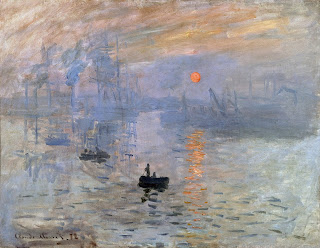Romantic Era: Realist Art Compared to Impressionist Art
Impressionist Art
Impressionism is probably my favorite type of art. A lot of paintings done in this style have a lot of "blurred" detail almost making the art look unfinished. To me, it would take a lot of skill, patience, and will to intentionally paint something whose end product has so many blurred lines and details.
Claude Monet, Impression Sunrise, 1872.
Just look at how Monet added the reflections in the water but yet left blurred lines some of which create the ripples in the water. This is a beautiful representation of a sunrise on the water. This is the painting that paved the way forward for impressionism. With the free-flowing lines and lack of a set of rules, this quickly became a popular type of art. Monet also used this scene of a picturesque sunrise to also portray the dawn of a new industrial era.
Elmer MacRae, Back of Old House, 1910.
In impressionist art, it is normal to see the strokes from the artist and it is no longer cliche. In impressionism, the focus was more on the artist and their intentions than the art itself. As you can see in MacRae's painting above you can make out nearly all the brush strokes of the artist while they used different shades and colors to bring out natural lighting.
Realism
1822-1899
Realism is my second favorite style of art. It shows an almost picture representation of a scene. This style tends to try and replicate real life hence the name. The painter of the above painting Bonheur was a famous female painter and sculptor who painted a lot of scenes and animals. You can still see some brush strokes in this piece. She uses a dark background with a lighter foreground to add depth to this painting. As for the horse she uses lightness and darkness to not only add depth but to also highlight the muscle and skeletal structure of the horse.
1849-50 The Stone Breakers Gustave Courbet
The artist Courbet received criticism for this painting. People in the art world contested that because the scene that Courbet depicted was not considered High Art. Courbet's intention in this painting was to show the plight of the commoner or poor class of people. The contrast between light and dark in this painting makes it look like it was a steaming hot day of pounding rock for a roadway.
Artvee. “White Horse by Rosa Bonheur.” Artvee, artvee.com/dl/white-horse/. Accessed 25 Mar. 2024. https://artvee.com/dl/white-horse/
Gleeson, Dr. Maura, and Dr. Maura Gleeson. “Claude Monet, Impression, Sunrise.” Smarthistory, https://smarthistory.org/claude-monets-impression-sunrise/. Accessed 25 Mar. 2024.
“An Introduction to Impressionism.” Greenwich Historical Society, 21 Sept. 2021, https://greenwichhistory.org/an-introduction-to-impressionism/
“The Stone Breakers.” Wikipedia, Wikimedia Foundation, 22 Jan. 2024 https://en.wikipedia.org/wiki/The_Stone_Breakers





I think impressionism vs realism is a long standing debate amongst paintings, and I'd certainly take the side of realism. That being said, I love the works you posted! There's something about "Back of The Old House" that works so well with the style- like the vagueness of it allows you to really project whatever memories of a simple farmhouse you have onto it. Whether you saw it is passing while driving down a country road, or if it reminds you of the house you or your cousins grew up in. Realism has always fascinated me as I've never been able to put on paper what I see with my eyes. But there's definitely something to be said about the skill it takes to convey emotions and a story through blurred lines and dots. I appreciate both the paintings you chose to cover, as well as the contrast between realism and impressionism you've pointed out!
ReplyDeleteMonet's depiction of the sunrise on the water, with its reflections and blurred lines, truly captures the essence of Impressionism and its departure from traditional art conventions. The free-flowing lines and lack of strict rules indeed marked a significant shift in the art world, paving the way for this popular style. Your analysis of Elmer MacRae's "Back of Old House" exemplifies how Impressionism embraces the artist's brushstrokes and focuses on capturing natural lighting. I think Gustave Courbet's "The Stone Breakers" elicits powerful emotions, portraying the struggles of the working class. Despite facing criticism for his choice of subject matter, Courbet's use of light and dark contrasts effectively conveys the harsh realities of laboring under the sun. Thank you for sharing these insightful reflections on these remarkable artworks!
ReplyDelete